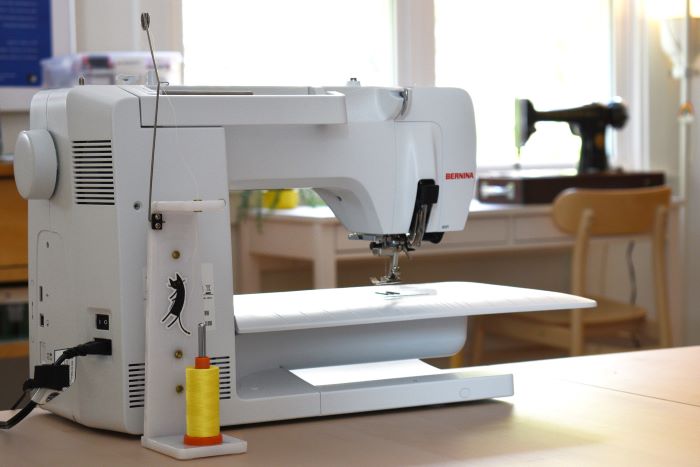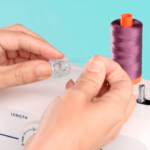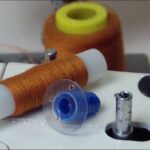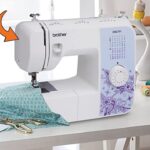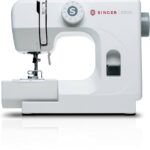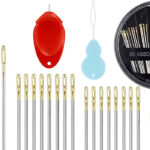In this post, we will discuss what is a spool pin on a sewing machine, the importance of spool pins, the alternative to spool pins, and much more. Let’s dig into the topic without wasting time. According to some posts on the internet, with the spool, you can change the tension of the thread. The spools on a sewing machine are not adjustable and cannot be moved up or down to change the tension of the thread.
In order to adjust the tension of the thread tension discs are used, which are usually located above the needle on the machine. These discs apply pressure to the thread as it passes through, creating the necessary tension for proper stitching.
What is a spool pin on a sewing machine?
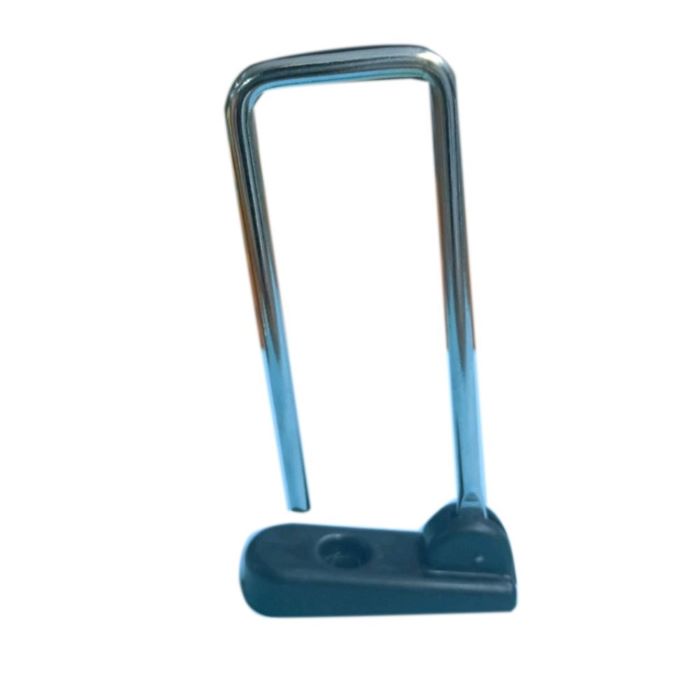
Spool pin sewing machine definition: A spool pin on a sewing machine is a small metal or plastic rod or spindle. Its purpose is to hold a spool of thread in place while sewing. It is typically located at the top of the sewing machine, near the thread tension mechanism.
The spool pin holds the spool of thread in place. It is designed to rotate freely, allowing the spool to spin as the machine sews so that the thread can be pulled off the spool smoothly and without tangling.
Some sewing machines have multiple spool pins, which can be useful for sewing with multiple colors or types of thread. Additionally, some of them are designed to accommodate different types of thread, such as large or small spools, or cones of thread.
What are the different types of spool pins?
There are several different types of spool pins that can be found on sewing machines, depending on the brand and model of the machine. Here are some common types of spool pins. With this, you can sew at high speed.
Vertical Spool Pin
This is the most common type of spool pin and is usually found on the top of the sewing machine. It is a vertical pin that holds the spool of thread in place and allows the thread to feed through the machine smoothly.
Horizontal Spool Pins
A horizontal spool pin is located on the side of the machine and is designed to hold the spool of thread horizontally. This can be useful for certain types of thread, such as metallic thread or thread that is prone to tangling.
Extra-Tall Spool Pin
This type of spool pin is longer than the standard spool pin and is designed to hold taller spools of thread, such as cone-shaped spools. This is very helpful in the sewing machine function.
Dual Spool Pins
Some sewing machines have two spool pins, which can be useful for sewing with two different colors of thread or for using a twin needle.
Thread Stand/holder
Some sewing machines come with a separate thread stand, which holds the spool of thread away from the machine. This can be useful for using large spools or cones of thread and can help prevent the thread from tangling or breaking.
It’s important to note that not all sewing machines will have all of these types of spool pins. Some machines may only have one type, while others may have multiple options.
Alternate to spool pins on the sewing machine
While spool pins are the most common way to hold a spool of thread on a sewing machine, there are a few alternatives that can be used in certain situations. These alternatives can be useful in certain situations, spool pins are generally the most reliable and convenient way to hold a spool of thread on a sewing machine.
Cone holder
A cone holder is a device that can be attached to the top of the sewing machine or placed nearby that holds a cone-shaped spool of thread. Cone holders can be especially useful for sewing with larger spools of thread that would not fit on a standard spool pin.
Thread net
A thread net is a small, stretchy net that can be placed over a spool of thread to help prevent the thread from tangling. This can be especially useful for slippery or delicate threads.
Thread stand
As mentioned earlier, some sewing machines come with a separate thread stand that holds the spool of thread away from the machine. This can be a good alternative to using a spool pin on the machine itself, especially for large or heavy spools of thread.
Can a sewing machine work without a spool pin?
No, a sewing machine will not work properly without a spool pin. It is an essential component of the sewing machine’s threading system, as it holds the spool of thread in place and allows the thread to unwind smoothly as the machine sews. Without a spool pin, the spool of thread would not be properly supported, and the thread would likely become tangled or otherwise misbehave, which can cause stitching problems and potentially damage the machine.
Additionally, the thread would not be able to be fed through the machine properly without a spool pin, which means that the machine would not be able to stitch correctly. Therefore, it is important to ensure that your sewing machine has a properly functioning spool pin in order to sew effectively.
How to fix or maintain a sewing machine spool pin?
The method to fix a spool pin on a sewing machine will depend on the type and severity of the problem. Here are some steps you can follow to troubleshoot and fix it.
Step 1. Check if the spool is bent or broken
Check the spool pin for any visible damage or wear. If it is bent, broken, or shows signs of wear, it may need to be replaced. Check your sewing machine’s manual or contact the manufacturer to order a replacement spool pin.
Step 2. Check that the spool is installed correctly
Make sure the spool pin is securely attached to the sewing machine. Some spool pins can be screwed or snapped into place, while others may be held in place by a clamp. Check that it is firmly attached and not loose or wobbly.
Step 3. Clean the spool
Clean the spool pin and surrounding area. Dust, lint, and debris can build up around the spool pin, which can cause it to function improperly. Use a small brush or vacuum to remove any debris from the area.
Step 4. Lubricate the spool pin
If the spool pin is difficult to rotate, you can apply a small amount of sewing machine oil or lubricant to the pin to help it move more smoothly. Be sure to wipe off any excess oil before using the machine.
Step 5. Use spool cap
If the spool pin is too small for the spool of thread you want to use, you can try using a spool cap or foam pad to hold the spool in place on the pin. If you have tried these steps and the spool pin is still not working properly, you may want to consult a sewing machine repair technician or contact the manufacturer for further assistance.
Final thought:
What is a spool pin on a sewing machine? The spool pin is an essential component of the sewing machine, as it ensures that the thread spool is held securely in place and that the thread is delivered to the needle smoothly and consistently. Some spool pins are designed to be removable, which allows you to switch out different types of spools or use different types of thread without having to transfer them to a separate spool holder.
It’s important to ensure that the spool pin is properly installed and secured before you begin sewing. An improperly installed spool pin can cause the thread to tangle or break during sewing. Additionally, it’s essential to use the correct size of the spool on the spool pin to ensure that it fits securely and doesn’t wobble or move during sewing.
Overall, the spool pin is a relatively simple but essential component of any sewing machine. Ensuring that the thread spool is held securely and delivered smoothly to the needle, helps to ensure that your sewing projects are successful and enjoyable to create.
It is essential for smooth and even stitching. Without a spool pin, the thread spool would be free to move around, which could cause the thread to tangle or break, resulting in uneven stitches or even sewing machine jams.
Additionally, a spool pin allows you to use larger spools of thread that may not fit in your machine’s built-in thread compartment. By using a spool pin, you can place the spool in a location that won’t interfere with the machine’s operation, giving you greater flexibility in the types of threads you can use.
A few other purposes of spool pins are: They come in different sizes and styles, They are removable, you can add additional spool pins, you should clean your spool pin regularly, and some spool pins have built-in thread guides.
Yes, a spool pin is typically used for holding a spool of thread on a sewing machine. It provides a stable and secure location for the thread spool, allowing the thread to be pulled through the machine’s various guides, tension discs, and needles to create stitches. Without a spool pin, the thread spool would be free to move around, which could cause the thread to tangle or break, resulting in uneven stitches or even sewing machine jams.
If you’re looking for a spool pin for holding a spool of thread on your sewing machine, you should consult your sewing machine’s manual to determine the correct type of spool pin to use. There are different sizes and styles of spool pins, depending on the sewing machine model, and some of them are designed to accommodate different spool sizes. Additionally, some spool pins are removable or can be repositioned to accommodate different thread types or spool sizes.
If you are interested in sewing then you must read about the features of more advanced sewing machines and ergonomic chairs.

